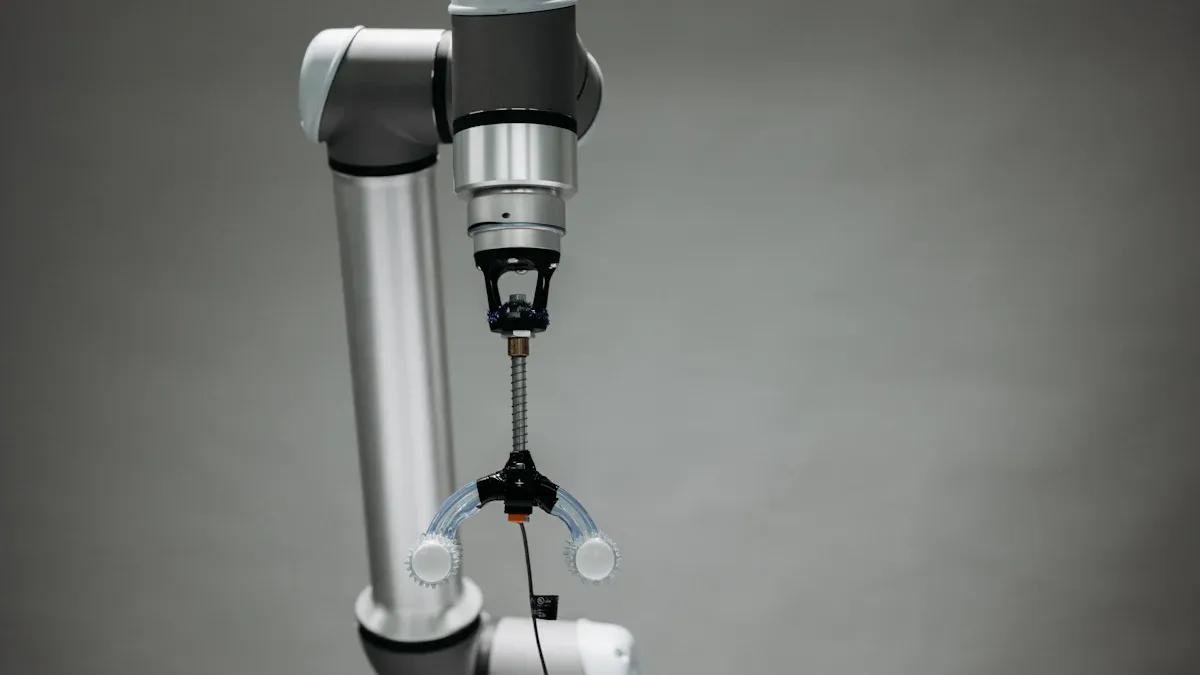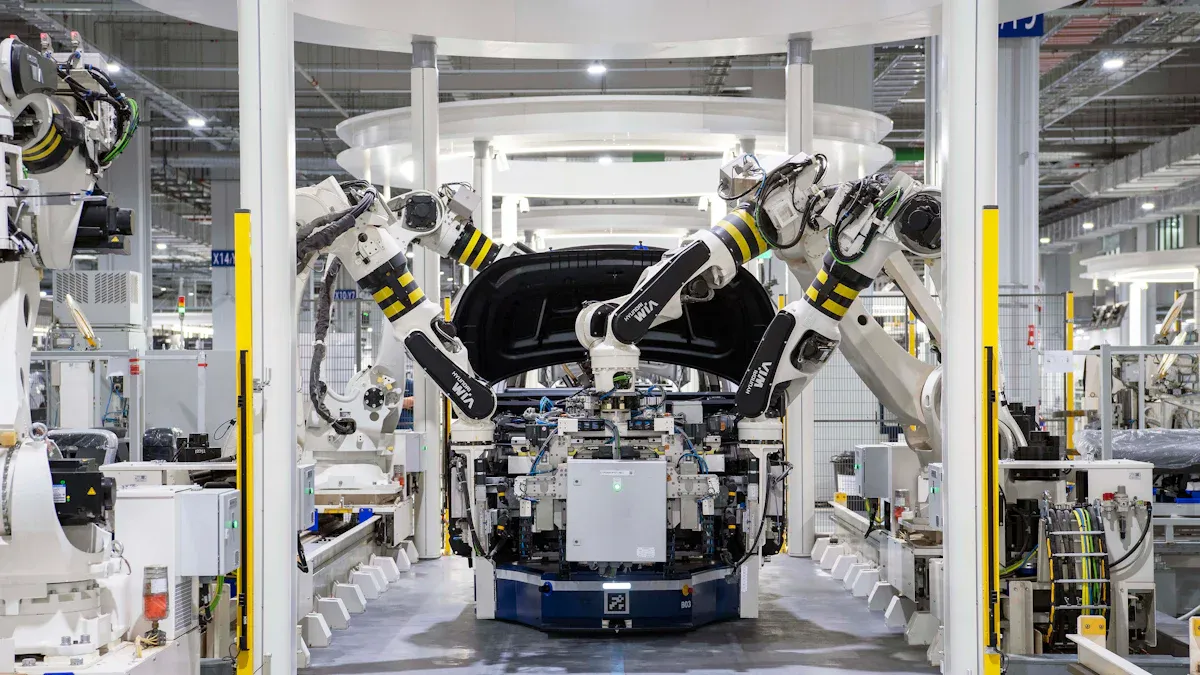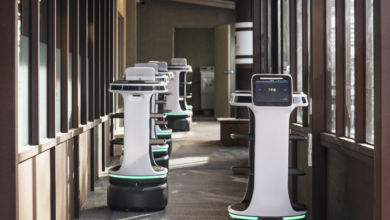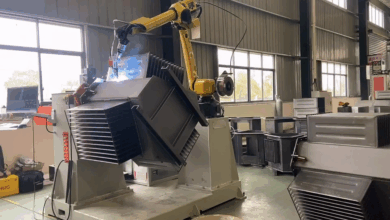What is a Four-Axis Robot?
A four-axis robot has four axes to help it move things. Each axis lets the robot move in a certain way or turn. Four-axis robots are fast and very steady. They are also easy to control. Many factories use these robots for jobs that need quick and exact moves.
Four-Axis Robots Overview

Axis Functions
An axis is a way a robot can move or turn. Each axis lets the robot move in a new direction. Most four-axis robots have three axes that move straight: X goes side to side, Y goes front to back, and Z goes up and down. The fourth axis lets the robot twist its wrist or tool. This setup helps the robot pick up things, move them, and turn them to put them in the right spot.
A four-axis robot is good at moving and controlling things. It can reach, lift, and turn objects quickly and accurately. The design is simple, so it is easy to program and fix. Many factories use four-axis robots because they do not need hard controllers or special training.
|
Axis
|
Primary Function
|
Contribution to Robot Performance
|
|---|---|---|
|
Axis 1
|
Controls base rotation (left to right, 180°)
|
Enables horizontal movement and positioning of objects along a line
|
|
Axis 2
|
Controls lower arm movement (forwards/backwards)
|
Allows lifting and moving objects along x and y axes
|
|
Axis 3
|
Controls upper arm movement (vertical reach)
|
Expands vertical reach, making parts more accessible
|
|
Axis 4
|
Controls wrist rotation (end-effector orientation)
|
Allows rotation of objects, enabling precise orientation and dexterity
|
The first three axes help the robot’s wrist get to the right spot. The fourth axis lets the robot turn its wrist. This helps the robot do jobs that need both moving and turning. Four-axis robots are fast and work well for jobs like picking up and putting down parts.
Four vs. Six Axes
Four-axis robots and six-axis robots both help factories do jobs. They each have their own strengths. Four-axis robots move in three ways and can turn their wrist. Six-axis robots can also twist and bend in more ways, called pitch and yaw.
|
Feature
|
Four-Axis SCARA Robot (EVS3-400)
|
Six-Axis Robot (6kg payload, 917mm reach)
|
|---|---|---|
|
Degrees of Freedom
|
4 axes (horizontal arm movement, cylindrical coords)
|
6 axes (X, Y, Z + roll, pitch, yaw)
|
|
Movement Capability
|
Primarily horizontal arm motions
|
Complex, multidirectional maneuvers
|
|
Payload Capacity
|
3 kg
|
6 kg
|
|
Reach
|
400 mm
|
917 mm
|
|
Repeatability Accuracy
|
±0.01 mm
|
±0.02 mm
|
|
Typical Applications
|
Pick-and-place, assembly, material handling
|
Welding, palletizing, machine tending, complex assembly
|
|
Structural Characteristics
|
Compact footprint, fast and precise
|
Larger reach and payload, adaptable to complex tasks
|
|
Collaboration & Adaptability
|
Less collaborative, optimized for speed and efficiency
|
Collaborative, adaptable, suitable for human-robot interaction
|
Six-axis robots can move in more ways, so they do harder jobs like welding or working with machines. They need harder programming and more care because they have more joints. Four-axis robots are made for speed and simple moves. They are easier to program and fix, which saves time and money.
|
Aspect
|
Four-Axis Robots
|
Six-Axis Robots
|
|---|---|---|
|
Typical Use
|
Simpler applications like palletizing; limited rotational capabilities
|
Complex tasks such as welding, machine tending, and 3D movements requiring full flexibility
|
|
Degrees of Freedom
|
4 axes, usually with faceplate parallel to ground
|
6 axes, including wrist rotation, enabling complex 3D orientation and positioning
|
|
Programming Complexity
|
Relatively straightforward due to fewer axes and simpler kinematics
|
More complex due to advanced kinematics, inverse kinematics, and 3D motion programming
|
|
Programming Methods
|
Basic programming, often manual or simple teach pendants
|
Requires sophisticated software, teach pendants, and offline programming tools
|
|
Maintenance
|
Simpler due to fewer joints and less complex mechanics
|
More complex but improving with modular designs and better software, still inherently more involved
|
|
Control Systems
|
Less complex control algorithms
|
Advanced control systems with real-time kinematics and sensor integration
|
EVST has a lot of experience with four-axis robots. Their robots help factories work faster and more accurately while saving money. EVST’s robots are easy to set up, work well, and are trusted in many industries.
Types and Applications


Four-Axis Robot Types
Robotics experts put four-axis robots into three groups: SCARA, delta, and articulated. Each group has its own look and job.
|
Robot Type
|
Joint Configuration
|
Degrees of Freedom
|
Description
|
Typical Applications
|
|---|---|---|---|---|
|
SCARA
|
2 revolute, 1 prismatic
|
4
|
Fast, precise, and compact; moves in a cylindrical space
|
Assembly, material handling
|
|
Delta
|
Parallel arms, 3-4 motors
|
3
|
High-speed, parallel movement; best for light objects
|
Pick-and-place, packaging
|
|
Articulated
|
3+ revolute joints
|
3+
|
Mimics a human arm; handles heavier loads
|
Welding, tool handling, assembly
|
SCARA robots are quick and work well side to side. Delta robots use arms that move together for fast jobs. Articulated robots have joints like a person’s arm, so they can do harder work.
Industrial Uses
Factories use four-axis robots for many jobs. These robots put together electronics, pack food, and sort things. In car factories, robots help weld and move parts. Electronics factories use them to screw in parts and add labels. Robots also work in clean rooms for medicine and health products.
EVST’s four-axis robots are often used to build electronics and pack items. They are chosen when speed and accuracy are very important.
Advantages
Four-axis robots have many good points:
-
They are fast and accurate for doing the same job over and over.
-
Their simple design makes them easy to use and fix.
-
They are small, so they fit in tight places.
-
They cost less than more advanced robots.
Many companies pick a four-axis robot because it is dependable and saves money. These robots can work all day, make fewer mistakes, and help businesses spend less on workers.
Four-axis robots have a fourth joint for more movement. This helps them do many jobs in factories.
-
These robots load machines, put things together, and pack items fast and well.
-
They work in small spaces and are not too expensive. They are good at their jobs and fit where needed.
-
EVST gives strong robot choices for these kinds of work.
FAQ
What jobs can a four-axis robot do?
A four-axis robot can pick and place items, pack boxes, and help build products. Many factories use these robots for fast and accurate work.
Tip: Four-axis robots work best for simple, repeated tasks.
How does a four-axis robot move?
The robot moves side to side, forward and backward, up and down, and can twist its wrist. This lets it reach and turn objects easily.
Why do factories choose four-axis robots?
Factories choose four-axis robots because they cost less, work quickly, and need little maintenance. These robots fit well in small spaces and handle many jobs.




